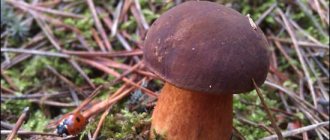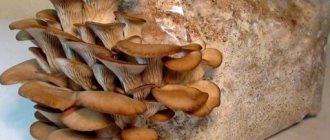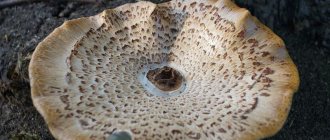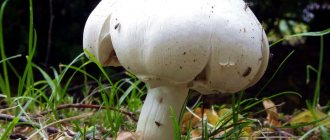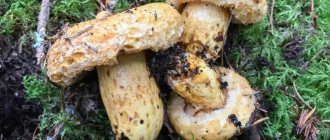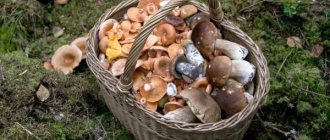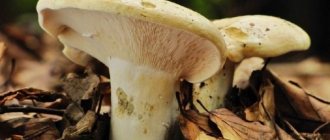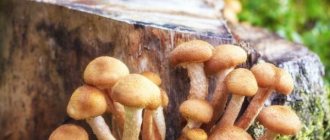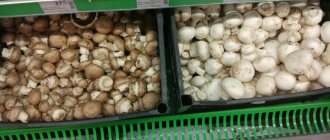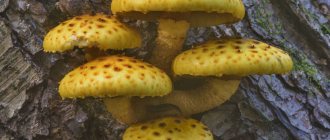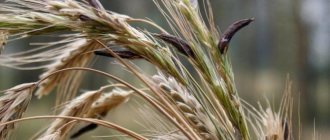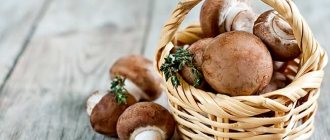Types of mushrooms to grow all year round
Of course, some of the methods described are only good at certain times of the year. It is difficult to grow mushrooms outdoors if the ground is frozen or covered with a thick blanket of snow. But in specially equipped rooms - greenhouses, basements - you can harvest crops all year round. The most common species suitable for year-round cultivation are oyster mushrooms, champignons and shiitake.
Oyster mushrooms
They are the most unpretentious species. They require minimal conditions and investments, quickly produce the first harvest and bear fruit for quite a long time.
The substrate can be wheat, rye, or barley straw, which must certainly be fresh, clean, dry, and free from mold and foreign odors.
Oyster mushrooms do not require special lighting; they can survive with virtually no light. It is better to place them in basements, filling polyethylene bags with substrate with mycelium, located on racks or suspended from the ceiling.
The bags are first cut lengthwise, and it is at the cut sites that mushrooms appear. An indispensable condition for successful cultivation is a gradual decrease in temperature - thus simulating the onset of autumn cold - the time of active ripening of oyster mushrooms in nature.
Champignon
Unlike oyster mushrooms, champignons are capricious and require certain conditions. However, the taste qualities are so high that they are worth fighting for.
Champignons love moisture, shade, high-quality compost, and horse manure. It is better to place mushrooms in special rooms where it is possible to regulate the temperature, since at different stages of growth they require different temperature conditions.
The optimal soil is considered to be manure, preferably horse manure, but if it is not available, cow manure diluted with straw and leaves may be suitable.
Champignons do not grow immediately. Their shoots look like mold, from which a small mushroom resembling a nodule gradually forms. And only after 45 - 55 days can you boast of the first harvest. Champignon mycelium bears fruit for up to three months.
Shiitake
A popular product of the countries of the Far East, shiitake mushroom is a relatively recent guest on the tables of our compatriots. It is believed that in terms of taste it is significantly ahead of oyster mushrooms and champignons, and in terms of the method of cultivation it is a worthy competitor to them. These exotic mushrooms are quite capable of growing at home and in the country, and not just in specialized premises.
Shiitake is grown either in substrate or on beams and stumps. The optimal substrate for it is sawdust - up to 90%, and various additives. It is preferable to choose sawdust from hardwood, for example, oak, beech, maple, alder, birch, and aspen.
Deciduous stumps and beams are also required. Mycelium is added to the holes made. No matter how shiitakes are grown, humidity and darkness are a prerequisite for them. Shiitake plants actively develop in natural conditions during the rainy season. Accordingly, when cultivating at home, they require active “bathing” and moisture.
Mushrooms germinate for a long time, up to 2-2.5 months, in warm conditions, and ripen in cool and humid conditions, yielding a harvest within 4-6 months.
Where to begin?
First you need to determine the room where you plan to grow champignons. A barn, greenhouse, basement, garage and even a balcony may be suitable for this. Like oyster mushrooms, champignons love high humidity, good ventilation and moderate temperatures. Light is an important condition, but not the main one. The best temperature for mushroom growth is from 12 to 20 degrees and air humidity in the range of 50-55%. For production you will need racks, plastic boxes for planting, fans and thermometers to monitor the temperature of the substrate and air.
What mushrooms are grown at home?
Every year, growing mushrooms at home is becoming increasingly popular. Unfortunately, not all varieties of mushrooms can be grown in this way; some of them are too capricious to environmental conditions, others require serious financial investments. Based on this, before you start mushroom growing yourself, you need to find out what mushrooms are grown at home. Most often these are the following types:
- Champignons (all varieties), volvariella, ringwort, puffball, dung beetle. These are soil fungi; they usually grow in fields or meadows in the humus layer of soil.
- Oyster mushroom (all types - ordinary, royal, pink, lemon), honey mushrooms (winter, summer, poplar, marble), hericium, tinder fungus, shiitake. These types of fungi grow on the wood of dead trees or plant debris containing cellulose.
Porcini mushrooms, chanterelles, boletus, boletus, truffles, morels, saffron milk caps. These are mycorrhizal fungi that form a symbiosis with the roots of only certain trees. They are grown artificially from purchased mycelium (mycelium - sprouted mushroom spores that are placed in a substrate), but breeding these species at home is quite difficult.
The most unpretentious of all and the easiest to grow at home are oyster mushrooms, shiitakes, winter mushrooms, champignons and ring mushrooms.
All of the listed species have certain requirements for living conditions. All that remains is to figure out which ones exactly.
Oyster mushroom ranks first in terms of prevalence and ease of cultivation. For beginning mushroom growers, experienced entrepreneurs who have been involved in mushroom growing for quite a long time offer to start growing mushrooms with it. When artificially growing oyster mushrooms, the costs required are less than for all other mushrooms. Oyster mushroom is distinguished by its unpretentiousness, excellent taste, early ripening, excellent yield, high resistance to viruses and bacteria, as well as a fairly long shelf life. Oyster mushrooms are grown in plastic bags (with substrate, mushroom mycelium and bio-additives), on stumps, sawdust of various trees, straw, husks, and corn stalks. Mushrooms grow well in rooms with a humidity of 80-85% and at fairly wide temperature ranges (from 10 to 30C, average values 16-20C). The first harvest of mushrooms can be harvested after 30 days (in winter after 45). From one mushroom block at a time it is possible to harvest an average of 2.5-3 kg of crop. At the same time, service 100 blocks on an area of 30 square meters. even one person can do it without any problems. Mushrooms produce crops for 5 years.- Champignons occupy the next place in popularity of cultivation, both in industrial farming and at home. They are much more demanding in terms of conditions of detention. And the technology for growing them is more expensive than for growing oyster mushrooms. Champignons are grown in bags or boxes with soil in which the mycelium is placed. Champignons grow well in dark, cool rooms (12-18C, maximum value no more than 28C) with a humidity of 65-85%. The first harvest of mushrooms is ready for harvest in 45-50 days, and subsequent ones can be harvested within 3 months.
Shiitake is not only tasty, but also a very healing mushroom (it is successfully used in the treatment of cancer). Until some time it was grown only in Asian countries. Shiitake is one of the most expensive mushrooms (the price is about $50 per 1 kg). Grows well at an average temperature of 12C. It is grown on pieces of wood and on various substrates. It is important to know that in order to get a harvest of truly tasty and healthy shiitakes, the mycelium for cultivation must be purchased from Japan or China, but not from Europe, because it is spoiled by selection. The first harvest, as a rule, occurs only in the next year and will last up to three years.- Winter honey fungus is a fairly cold-resistant mushroom; it grows well at an ambient temperature of 1-2°C. This mushroom has a pleasant taste and good nutritional qualities. It perfectly adapts to parasitize trees with living wood, and for this reason it should not be grown in home gardens or vegetable gardens; it is recommended to grow it only on substrates and timber logs indoors.
- Ringweed is a not very well-known mushroom. Its cultivation began relatively recently, only about 25 years ago. This mushroom looks like boletus, but in taste it competes with champignons. It is grown in the garden directly in open ground beds or in plastic bags and boxes.
Harvesting
About 20 days after the last stage (gobting), it is time to harvest. It lasts from 1 month to two. Mushrooms appear in “waves,” and the compost must be watered after each one. Champignons are collected without the help of a knife, by hand. To do this, you need to carefully unscrew the mushroom. Harvest the entire crop, without any leftovers. This will quickly cause a new “wave” of growth and protect new mushrooms from attack by pests.
Once the harvest is complete, the compost should be removed and the racks and bins disinfected. In addition, throughout the entire stage of growing mushrooms, periodically treat the room with bleach or potassium permanganate solution. Pests and diseases love a humid environment and tend to multiply in it with a vengeance, and this will be detrimental to future champignons.
Which mushrooms are better - forest or greenhouse mushrooms?
Mushrooms are an amazingly valuable product. In terms of popularity of use by fasting people and vegetarians, they firmly hold first place. But many people often face the question: which mushrooms are better to eat - forest or greenhouse mushrooms? Let's try to figure it out.
First, let’s remember why mushrooms are so valuable. It must be said that this healthy product contains almost everything you need - proteins, fats, carbohydrates, vitamins, mineral salts, and everything in reasonable proportions. It should be noted that the quality of mushroom protein is almost identical to meat protein, but it is easier to digest, and in terms of the amount of phosphorus content, mushrooms almost catch up with fish. The valuable properties of mushrooms are not lost during any processing.
Perhaps the only drawback of mushrooms is that they contain chitin, and therefore can be difficult to digest.
For this reason, they are not given to children under three years of age and to those who suffer from metabolic disorders and various stomach diseases.
What mushrooms do we usually bring from the forest?
White mushroom Photo: alex80, pixabay.com
First of all, everyone will call white mushrooms, or boletus mushrooms, these are the kings of mushrooms! They are incredibly tasty, you can use them to prepare almost any dish, cook soup from fresh or dried, fry, make mushroom caviar, and much more!
Honey mushrooms are probably the most popular of all mushroom gifts from the forest. Firstly, they grow in large families and it is not difficult to collect a lot of them. Secondly, they are great canned, and simply fried they are very tasty.
Saffron milk caps, russula, aspen mushrooms, boletus mushrooms, boletus mushrooms, oyster mushrooms - there are so many types of them! And we also forgot about morels and strings that appear in the forests near Moscow in the spring. Unfortunately, they are not suitable for canning, but quickly fried with onions and herbs, they will be perfect for the spring table.
What about champignons and truffles, you ask? We will specifically mention them at the end, because both of them are both forest and greenhouse, that is, grown in special conditions, so we will move on to discussing them.
Champignons Photo: Alexandr Kalyaev, Shutterstock.com
The most popular greenhouse mushroom is, of course, the champignon. At any time of the year, in any store, I think you can buy them both fresh and frozen.
Five minutes, and the champignons will be ready... Photo: Mira Sim (simira), personal archive
To be honest, I’ve never eaten truffles... I know that they are also often grown in greenhouse farms and that they are incredibly tasty and... expensive. One way or another, you definitely need to write about them.
In Georgia, oyster mushrooms have recently begun to be actively grown in greenhouses; they are available in large stores at any time of the year. It is quite possible that in Russia this type of mushroom is also popular in artificial cultivation.
Now let's talk about the advantages and disadvantages of mushrooms collected in nature and those that grew under film.
Oyster mushrooms Photo: drandym16, pixabay.com
Let's start with greenhouses .
Greenhouse mushrooms will never be poisonous! We feel free to buy them in the store and can be one hundred percent sure that we will not get poisoned. Of course, this is provided that they are fresh.
Mushrooms from greenhouses are cleaner than forest mushrooms; they have already been sorted and sorted by size; they are technically easier to process when cooking.
They are there at any time! In the summer heat or in the winter cold, you can always buy them. And they are always fresh; there is no need to preserve them to treat yourself to mushrooms in winter.
And now about the disadvantages of greenhouse mushrooms:
They are expensive... Whatever one may say, provided that there is a branded store near you from some greenhouse farm and the prices there are minimal, wild mushrooms will still be cheaper, because the most you will spend on them is a train ticket or bus! I’m generally silent about truffles - I saw them in our supermarket and was horrified by the price tag. In addition, I don’t know where, how, but in my city, during fasting, prices for mushrooms are cleverly increased - consumption increases and they will buy it anyway, even at an expensive price.
The choice of greenhouse mushrooms is still scarce... They have never grown in greenhouses and are unlikely to grow porcini mushrooms, boletus, honey mushrooms, spring morels and string mushrooms also grow exclusively in nature...
These are the mushrooms that grow in the Moscow region! Photo: Mira Sim (simira), personal archive
Artificially grown mushrooms are poorer in the content of nutrients and taste slightly worse. Try to compare champignons from the store and from the forest - they are completely different.
Let's return to wild mushrooms again and mention their benefits:
Their selection is simply huge! Dozens of types, all so different and all delicious.
Picking mushrooms in itself is a great pleasure, and it is very rewarding in every way. A pleasant pastime with loved ones, a long walk in the fresh air (you can’t pick mushrooms in half an hour), purely aesthetic pleasure from nature.
They're cheap! You collect them for free, well, maybe you’ll spend money on travel to the forest.
They can and should be preserved. Nobody cans store-bought ones, they are always available, but opening a jar of honey mushrooms or taking crispy milk mushrooms out of a barrel is an extraordinary pleasure in winter.
But forest mushrooms are fraught with danger, and more than one!
They can be poisonous... I will not list the types of poisonous mushrooms, suffice it to say that the most dangerous are the false ones, very similar to their forest brothers. There are also hallucinogenic mushrooms, which also have “correct” doubles.
Forest mushrooms grown in an ecologically unfavorable zone will bring a lot of other rubbish into your stomach in addition to vitamins, and in large quantities, since they perfectly absorb toxins and radioactive waste from the soil.
Even edible mushrooms that are improperly preserved or stored for a long time carry a terrible threat. Therefore, mushrooms must be prepared for the winter in jars very carefully and stored for no more than one winter.
What to do, what to choose, you ask? It’s up to you to decide which mushrooms to eat; we have already discussed all the pros and cons in detail. In any case, bon appetit!
Sanitary requirements for products, GOST
Mushrooms intended for human consumption are subject to declaration for compliance of product quality with GOST requirements. The rules and declaration schemes are regulated by the Regulations of the Customs Union TR CU 021-2011. On a voluntary basis, you can obtain a certificate for products after conducting laboratory tests in an accredited organization. In this case, not only the manufacturer (declarant), but also the certifying body is responsible for the quality of the product. A declaration and certificate are required when supplying products to catering establishments or retail chains.
Basic documents establishing requirements for the quality of mushrooms:
- GOST 56827-2015 - fresh champignons;
- GOST 56636-2015 - cultivated oyster mushrooms;
- GOST 28322-2014 - mushroom processing products;
- GOST R 55465-2013 - frozen products;
- GOST 33318-2015 - dried mushrooms.
The declaration is drawn up by the product manufacturer or importer. To obtain it, it is necessary to conduct a product study in your own or independent laboratory and submit a protocol to the certifying authority. The declaration can only be obtained by individual entrepreneurs and organizations registered in the territory of the countries of the Customs Union.
How to grow strings and morels in the country
Mushrooms are capricious creatures, so luck is unpredictable. Take spring lines and morels, for example. In the forest they are called snowdrops, since sometimes they appear as early as April, when there is still snow in the dense spruce forests and along the ravines. These mushrooms do not have the usual shape, that is, a stem and a wide cap.
The lines are just brown lumps, the morels look like a cone. They grow on warmed soil, the first to become free of snow - along the sides of forest roads, in clearings, forest edges, and in open forests.
If you are too lazy to go into the forest or have no time, you can try growing these first mushrooms in the garden. By the way, in Western European countries and the USA they are considered a delicacy and are served at ceremonial receptions and on the holiday table.
Strings and morels - mushrooms are noticeable in an empty forest: they are quite tall - 8, and sometimes 10-12 cm and wide - up to 5 cm in diameter.
Under what conditions can these mushrooms be grown in the garden? The first thing these mushrooms need in the garden is a sunny side. The second is a place that is not trampled. It usually occurs in subtrees. And the French, for example, grow strings directly in the beds, like vegetables.
Investments
An approximate business plan for growing mushrooms (oyster mushrooms) will help the entrepreneur figure out how much money he will need to invest in the business. To implement the project, you will need a room with an area of 60 m². In order to minimize costs, it is planned to use your own summer cottage. It is planned to organize two rooms - an incubator for growing mycelium and a chamber with good ventilation. Production volume – 2 tons of mushrooms per year for 6 production cycles.
- Construction of a greenhouse – 100 thousand rubles;
- Heater – 3 thousand rubles;
- Steam generator – 30 thousand rubles;
- Crushing apparatus – 25 thousand rubles;
- Humidifier – 7 thousand rubles;
- Hood – 4 thousand rubles;
- Containers for pasteurization 2 pcs. – 8 thousand rubles;
- Polyethylene bags 500 pcs. – 5 thousand rubles;
- Boxes 10 pcs. – 1 thousand rubles;
- Formalin solution for disinfection 2 kg – 100 rubles;
- Forks 3 pcs. – 1 thousand rubles.
- Other expenses - 10% of the total investment (28 thousand rubles).
Total: 203 thousand rubles.
The above business plan does not include costs for refrigeration equipment, staff salaries and training. It is assumed that the entrepreneur has a household refrigerator with a volume of at least 200 liters and will involve his family members to help.
Non-fixed amounts for the purchase of mycelium and the rental of a retail outlet on the market are added to the expenses. If the conditions are met, the payback period of the project is 9 months, net profit is 55 thousand rubles/month, profitability is 28%. In total, you will need to invest at least 250 thousand rubles.
To sell mushrooms, you will need to obtain a quality certificate. The declaration is issued based on tests carried out for the content of heavy metals, radionuclides, herbicides, pesticides and other components hazardous to health.
In fact, there shouldn’t be anything in farm mushrooms. The cost of certification starts from 2 thousand rubles, depending on the region and variety of mushrooms. Processing time ranges from several days to 3-4 weeks.
After receiving the document, mushrooms can be sold at the market, handed over for sale to vegetable kiosks or shops, offered to public catering establishments (restaurants, cafes, fast food), and canning factories.
As the farm develops, the best option would be to open your own processing plant to completely eliminate waste in the mushroom growing business.
How to grow honey mushrooms at your dacha
When talking about what mushrooms can be grown in the country, many people first mention honey mushrooms.
Who doesn’t know these cute babies with long legs, who grow as a friendly family on old stumps, fallen trunks, and sometimes on weakened deciduous trees.
This mushroom belongs to the category of wood-destroying mushrooms. This feature will have to be taken into account when planning to plant honey mushrooms in the garden. However, to grow, you don’t need to drag rotten stumps into the garden - mushrooms can grow on sawdust, straw, sunflower husks, and corn residues, and it’s best to mix these substrates. However, mushroom growers in this case are given the opportunity to experiment.
Before growing these mushrooms under artificial conditions, punctures are made in the prepared area of the substrate with a stick and an infusion of mature (with dark brown plates) honey mushrooms is poured in. For infusion, the crushed caps are poured with rainwater for a day.
If mushroom “dressing” is poured over the rotting trunks of cut apple or pear trees, then they must be chopped from above with an ax so that the surface is quite loose. In this case, the fungal spores will better penetrate inside the wood and will not dry out prematurely. The top of the “planting” must be covered with foliage, bark, etc. However, you will still have to water the substrate, even the wooden log, from time to time.
Honey mushrooms are good because under a favorable set of circumstances, if they like their new place of residence, fungi will appear within a month or a month and a half, but maybe even next year. They grow best in the shade rather than in the sun.
Honey mushrooms can also be propagated by pieces of dead wood from which the mushrooms were collected. These pieces should be abundantly penetrated with white threads of mycelium. If the mycelium takes root, honey mushrooms can be harvested twice a year - in summer and autumn.
Next, you will find out what other mushrooms can be grown in the country.
Arrangement of the premises
Knowing how champignons are grown on an industrial scale, it is worth properly preparing the room for all stages of this process. First, you will need to insulate the building from the outside, if this was not done by the previous owners or was not included in the construction project. This is necessary to grow mushrooms both in summer and winter.
Forced ventilation is installed in the room. It must be powerful and productive. Next, you need to think about a controlled, sensitive, quickly responding heating system. At the same time, the peculiarities of the microclimate in each production hall are taken into account.
You need to purchase irrigation equipment and prepare a room for compost production. The arrangement of each production zone is thought out separately. You will need to purchase light bulbs, containers for storing crops, temperature sensors and thermostats, as well as a humidity control system.
Growing porcini mushrooms in the garden
Another mushroom that is grown under artificial conditions are boletus mushrooms. Many people are no longer surprised by the appearance of porcini mushrooms in the garden.
This mushroom has a peculiarity - its mycelium is always intertwined with the roots of trees (pine is especially revered by boletus mushrooms). This means that mushroom peelings diluted in water should be poured under the roots of trees. Don't forget that spores are only in hats. And on the stem of the porcini mushroom, at the very base, particles of forest mycelium could have been preserved in the ground.
So the idea of growing porcini mushrooms in the garden does not look hopeless. You just need to remember that the boletus does not want to exist without trees; it is, after all, the king of the forest and will not take root in the garden bed.
If pine trees, or birches, or oaks grow nearby, you need to chop up the overripe caps and dilute them with non-chlorinated water. Rain water is best suited, it is soft, but river and spring water will also work. You need to keep the mushrooms in water for about a day and pour them onto the selected area.
If the mushroom is large, you can separate the tubular part from the dense pulp. Use the pulp immediately and use the tubular layer for propagation.
This method is even simpler. Under the top layer of soil with natural litter, pick it up with a spatula, place pieces of tubular spore-bearing mass, press with your foot and lightly moisten. This should be done at a distance of 1.5-2 m from the trunk, choosing an adult tree - 15-20 years old.
There is another effective way. It is often difficult to find an overripe mushroom in the current forest - mushroom pickers do not allow it to grow old before the spores mature. Then a piece of soil from the place where the desired mushroom was found must be carefully cut off along with the litter and planted near the house - preferably on the roots of the same tree near which the mushroom grew in the forest. Don't be greedy - a piece from a matchbox is enough. The new location of the mycelium must be moistened, but not watered abundantly - to avoid rotting.
The first fungi may appear next year. Over time, the mushroom family grows.
Now you know what mushrooms can be grown in the garden and how to do it, which means it’s time to act!
What mushrooms can be grown at home and in the garden?
At your dacha you can grow edible wild mushrooms of almost all popular types. Some of them are unpretentious and do not require special care. Others will require considerable patience, knowledge and experience.
All edible forest mushrooms that can be cultivated under artificial conditions can be divided into two groups:
- woody ones, which colonize tree stumps; these include oyster mushrooms, honey mushrooms, shiitake;
- ground ones, which form a fruiting body in the soil - these are champignons, porcini mushrooms, chanterelles, ring mushrooms, truffles.
The best manufacturers and brands of cultivated fresh mushrooms:
Determined annually based on the results of major exhibitions (Prodexpo, WorldFood Moscow, etc.), the results of inspections by Rospotrebnadzor, Roskontrol, Rostest, Roskachestvo, ratings from specialized agencies (Expertology, Rate&Goods, Productcenter, etc.) and customer reviews (Irecommend, Otzovik, Otzyv, Yandex Market, etc.).
ALMAZ ST (AUCHAN), CHUDOVO, GC PODMOSKOVIE, MUSHROOM RAINBOW, NGK KASHIRA (O KEY), RUSSIAN MUSHROOM, MASLYANINSKOYE LUKOSHKO, BONCHE (BILLA), MUSHROOM YARD, RUSSIAN FARM, MUSHROOM PARADISE (SPAR), FRUTORYAD (CAROUSEL), ORYX , PRINEVSKOYE, SOUTHERN MUSHROOM (TAPE), MY SUMMER, TERRA (BE HEALTHY), GLOBAL VILLAGE, etc.
If you would like to participate in determining the best manufacturers (trademarks), send your reasonable proposals for including/removing a brand from the list.
Features of growing mushrooms at home
At home, you can independently organize the cultivation of mushrooms in two ways:
- extensive - an environment natural for the development of a particular species is created, the mycelium is sown in cuts on stumps or placed in ridges on the site;
- intensive - a technique for forcing fruiting bodies in an enriched substrate under special conditions, can be used on a balcony, garage, basement, greenhouse.
Substrate selection
In nature, fungi actively interact with plant roots, forming a complex symbiotic system. For normal development, the mycelium needs wood cellulose - the main component of the nutrient substrate for growing mushrooms at home. For this purpose, you can use straw or sawdust from non-coniferous trees. It should be remembered that chopped straw of wheat, rye and barley is excellent for homemade champignons and oyster mushrooms, and shiitakes love sawdust of a 2-3 mm fraction from oak, maple or beech.
Beginners often prefer to start growing their own mushrooms using a ready-made substrate, which can be purchased in specialized stores. Traders offer so-called mushroom boxes - a set of mycelium and the required amount of compost. The set in a mushroom box allows the amateur to first become familiar with the cultivation technology at home, and then begin mastering the process of preparing compost.
Fungal spores or mycelium?
Mushrooms can be grown using both spores and mycelium. The debate about which planting components are preferable - spores or mycelium - has the same meaning as the discussion among vegetable growers about what is better - seeds or seedlings.
You can grow mycelium from spores using both dry and fresh mushroom caps. It is important that the source material is not previously dried in an oven or electric dryer, and that the round caps are not frozen. For propagation, the spore-bearing fungal layer should be crushed. Then it can be placed in a prepared and disinfected soil substrate or in a sugar solution (add 2 tablespoons of sugar and 1 g of potassium permanganate to a bucket of water from a reservoir, rainwater or well). Growing royal mycelium in an aqueous solution is more reliable.
If there is ready-made mother mycelium, then you must first multiply it to the required quantity and obtain an intermediate mycelium by sowing the mother material in a box with compost, or make grain mycelium.
To obtain grain mycelium, you need to boil the prepared grain in water for an hour, then cool it. Then you should fill the container (jar or plastic bag) halfway, sterilize the resulting set and sow the mother material into it. After two weeks, the grain will be covered with a white fluffy coating. This is the grain planting mycelium.
How to prepare the nutrient medium?
The substrate in which the mushrooms will grow is the most important element of the technology. Proper preparation is the key to success in mushroom cultivation. For tree mushrooms (oyster mushrooms, honey mushrooms) the recipe is simple.
The main ways to obtain a nutrient medium:
- from straw - crush the straw of any cereals, except oats, to a fraction of 2-7 cm, rinse, pasteurize at a temperature of 80 degrees, cool and steam;
- from sawdust - hard wood species, except conifers, are suitable; the sawdust is washed and sterilized at a temperature of 120 degrees, cooled and steamed.
Components
There are many formulas for preparing nutritious soil. But there are components whose presence in compost is mandatory. All mixtures are made from manure. Horse manure is considered the best, but manure from pigs, cows, birds and sheep will also be effective. The second required component is straw or hay. They must be fresh and unrotted.
In addition to the above materials, various fertilizers are added to the compost: beet or potato tops, sunflower husks, beer grains or other organic waste. In addition, a good mixture requires the presence of nitrogen-containing components. For example, urea or ammonium sulfate.
Additives such as bone meal, cotton processing waste, and bran would also be useful. The presence of mineral elements - gypsum, chalk or superphosphate - is mandatory. Here is one of the most common formulas: for 100 kg of horse manure you will need 2.5 kg of gypsum, 50 kg of winter straw (chopped) and 15 kg of dried manure.
Features of growing mushrooms in the garden
The easiest way to grow mushrooms on your own plot is to grow them extensively, that is, to create conditions for them that are as close to natural as possible. For woody species you will need several stumps, preferably spoiled. They need to be placed in the shade, on beds of nutrient substrate prepared in advance.
The mycelium is sown in vertical cuts on the stumps. The remains of the mycelium are laid out around the stump. The sowing is completely covered with moist substrate and covered with film. After 2 weeks, a white coating of the finest threads will appear under the shelter. Then you can remove the film. Further care consists of watering and timely harvesting.
Ground varieties can be grown in compost beds in a shaded area or greenhouse. It should be borne in mind that no mushrooms like the proximity of fruit trees. At the dacha, excellent results are obtained by growing mushrooms in the basement or garage, where you can install a shelving system or devices for hanging bags of substrate.
- On the shelves. The most effective method. Gives the highest yields per unit area. To implement this method, you need to prepare a shelving system made of metal or wood, which consists of open cabinets with shelves 40 cm or more in height and up to 5 levels. Pallets or boxes with inoculated substrate are installed on the shelves. Aisles of at least 80 cm are left between the racks to make it convenient to approach the shelves from both sides.
For growing in beds, in bags or on racks, the general inoculation technique (sowing mycelium into the substrate):
- load compost heated to 27 degrees into containers in a layer of 30 cm;
- make holes on the surface at a distance of 20-25 cm from each other;
- grain mycelium is poured into the holes in a thin layer, compost mycelium is poured into handfuls the size of a tennis ball;
- planting material is sprinkled with soil to a height of 1-2 cm;
- the box is covered with transparent plastic film;
- after 2 weeks, a white coating in the form of threads appears under the film;
- remove the film;
- cover the surface 4-5 cm with substrate.
The set of equipment required for mushroom growing depends on the cultivation method. No special equipment is required for growing on stumps or beds. To grow in bags, you should take care of containers and hooks for hanging. With the racking method, it is necessary to prepare racks and containers for the substrate. With all technologies for growing mushrooms, you should acquire instruments for measuring climatic parameters - a thermometer and a hygrometer. If you decide to grow mushrooms indoors, then it must be equipped with a ventilation pipe.
Artificially grown mushrooms can be divided into two large groups:
- champignon grown in compost containing animal manure or bird droppings
- wood-destroying fungi that grow on a substrate consisting exclusively of plant materials:
straw, hay, sawdust, sunflower and buckwheat husks, cotton products.
Champignon
Compost, which is used in the production of champignon, is prepared from a mixture of straw, litter or manure with additives.
It is thoroughly mixed, moistened and left in piles to warm up. The piles are periodically moved from place to place to allow fresh air to flow in, or air is blown in special tunnels through cracks in the floor. This is necessary for the development of microorganisms that transform the components of the compost into a structure suitable for growing champignon. This is a long process during which large amounts of ammonia, carbon dioxide and water vapor are released. Properly prepared compost is a nutritious crumbly mass of dark brown color with a slight pleasant odor. The grain mycelium of champignon is placed in it. When it germinates, the compost is covered with specially prepared soil containing peat, it is called “cover soil”. The growing chambers maintain the necessary microclimate - humidity, temperature, ventilation and watering. When the champignons germinate through the cover soil and reach a certain size, they are collected from the racks all at once, sorted by size. Then the soil is moistened, leveled, and the mushrooms sprout again. Since champignons on one bed (rack) are not collected constantly, but periodically, it is customary to say that mushrooms grow in waves. On an industrial scale, it is customary to grow two to three waves, then the compost is taken out, the chamber is sanitized and new compost is brought in.
Wood-destroying fungi
which include oyster mushrooms, shiitake, all types of honey mushrooms, are grown on a plant substrate.
It is treated by exposing it to high temperatures to kill mold and bacteria spores. There are several processing technologies, the most promising are tunnel pasteurization (steam treatment) and autoclave sterilization. The first method is mainly used in the production of oyster mushrooms, and the second - in the cultivation of mushrooms, which are commonly called “exotic”. These are shiitake, eringi (royal oyster mushroom), honey mushroom (white marbled, winter, Japanese, poplar), and Judas's ear. After processing the substrate, grain mycelium is introduced into it in special rooms, observing strict sanitation, and germinated in incubators under certain conditions (incubated). The overgrown substrate is transferred to the growing chambers, or the conditions in the incubator are changed so that fruiting begins.
Each type of mushroom needs its own microclimate, but maintaining a certain temperature and humidity is mandatory!
These mushrooms also grow in waves, and in industry they grow one or two waves, then change the substrate.
For those fans who are interested in growing mushrooms themselves, we can offer a less complex technology, without special equipment and maintaining strict microclimatic parameters. This technology is called extensive and consists of planting mycelium on sticks of a certain type of mushroom in a cut of hardwood wood.
In some Asian countries, shiitake (see photo on the right) and auricularia auriculata (other names for this species are Judas ear, mu er) are grown on stumps on an industrial scale.
At your dacha or in your garden, you can grow 20 types of different mushrooms. This article provides detailed instructions for planting mycelium on sticks and growing mushrooms on wood cuts.
Preparing the substrate for oyster mushrooms
The straw is soaked for a day in warm water in a convenient trough or other container. After this, it is stacked mixed with layers of manure. You should get only 6-8 layers. We additionally moisten each layer with warm water. After 3-4 days, the compost needs to be thoroughly mixed and urea and superphosphate added. After this, the substrate will acquire a characteristic ammonia odor. After another 3-4 days, the compost is mixed again. So it needs to be shoveled 4-5 times, gradually adding the remaining minerals. During the final mixing, gypsum is added.
The average compost preparation time is 24–28 days. The completion of the fermentation process can be judged by the disappearance of the ammonia smell and the light brown color of the manure. During the fermentation process, the temperature of the compost can reach 50–70 degrees. To grow mushrooms, the compost temperature should be no more than 25 degrees.
